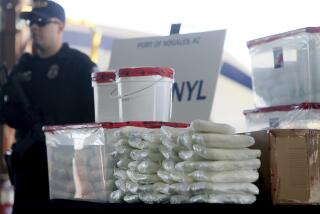Parents Underrate Children’s Exposure to Drugs
- Share via
WASHINGTON — With an increase in the number of preteens and teenagers who were offered illicit drugs last year, baby boomers are seriously underestimating the presence of drugs in their children’s lives, a national survey released Sunday concludes.
While parents recognize the severity of the nation’s drug problem, “few sincerely believe that their children are exposed to drugs, that drugs are widely available in schools their children attend,” said Richard D. Bonnette, president of the Partnership for a Drug-Free America, the survey’s sponsor.
This finding of the Partnership Attitude Tracking Study, which surveyed 9,712 children, teenagers and parents across the nation, is important because the study also found that drug use is significantly lower among children who learn about the risks of drugs at home. Only 28% of the kids said they learned a great deal about the dangers of drugs from their parents.
“Boomers, many of whom have ‘been there, done that,’ are surprisingly and ironically out of step with the reality of drugs in their children’s lives,” Bonnette said.
Illustrative of the problem in communication, 94% of parents surveyed said they talked with their sons and daughters about drugs over the last year. But only 67% of the children recalled those discussions.
“Research tells us that parents can prevent a variety of risky behavior among their kids, including drug use,” Bonnette said, citing the National Longitudinal Study on Adolescent Health, published in September by the Journal of the American Medical Assn.
“But taking action to protect your children first requires recognizing--and then believing--the possibility that your own kids are susceptible,” Bonnette said. “It’s easy to recognize the drug problem from a distance. But seeing it as a real threat to your own children is too close to home for some people.”
Key findings of the survey include:
* Twenty-eight percent of 9- to 12-year-olds were offered drugs in 1997, compared with 24% the year before and 19% in 1993.
* While a majority of fourth-, fifth- and sixth-graders believe that there are dangers in using drugs, the anti-drug attitudes weakened significantly from 1993. In 1997, about 84% agreed that using drugs is dangerous, down from 87% in 1996 and 90% in 1993.
* Forty-nine percent of the children surveyed in 1997 were less likely to tell their parents if someone offered them drugs, down from 55% in 1996 and 54% in 1993.
* Children’s exposure to marijuana, as measured by the statement that they had close friends who used marijuana sometimes, doubled from 7% in 1993 to 14% in 1997.
In the way of differing perceptions between the generations, the study found:
* Forty-three percent of parents believe that it’s possible that their children could find marijuana easily, while 58% of children say the drug is easy to come by.
* One-third of parents said they thought their children viewed marijuana as harmful; only 18% of the kids viewed it this way.
* Just 21% of parents said it was possible that their child might have tried marijuana, less than half of the 44% of children who said they had actually tried it.
The study found that trial use of marijuana increased significantly as children moved from grammar school into junior high or middle school. The data indicate that 7% of sixth-graders had tried marijuana at least once, a figure that jumped to 23% among seventh-graders and 31% of eighth-graders.
The tracking study is described by the Partnership for a Drug-Free America as the largest study of drug-related attitudes in the United States, and the only drug survey that collects data on children as young as 8 and 9.
*
The latest study was the 10th completed since 1987. In the study, 1,922 preteens, 6,975 teenagers and 815 parents completed self-administered, anonymous questionnaires.
The Partnership is a private, nonprofit coalition of communication professionals.






